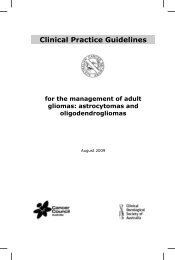Clinical Practice Guidelines for the management of locally advanced ...
Clinical Practice Guidelines for the management of locally advanced ...
Clinical Practice Guidelines for the management of locally advanced ...
You also want an ePaper? Increase the reach of your titles
YUMPU automatically turns print PDFs into web optimized ePapers that Google loves.
Evidence summary Level References<br />
Both <strong>of</strong> <strong>the</strong> two larger RCT subgroup analyses <strong>for</strong> biopsy proven<br />
node-positive disease that were examined showed that castration,<br />
ei<strong>the</strong>r LHRH agonist until progression or orchidectomy, resulted in<br />
significant overall and cancer-specific survival benefits when<br />
combined with radio<strong>the</strong>rapy<br />
Recommendation<br />
II 112-114<br />
If radical radio<strong>the</strong>rapy is given to patients with node-positive disease it is reasonable to <strong>of</strong>fer<br />
long-term androgen deprivation in addition to radio<strong>the</strong>rapy.<br />
Grade D<br />
3.3.2 External beam radio<strong>the</strong>rapy<br />
There are three randomised control trials examining radio<strong>the</strong>rapy alone as a treatment option <strong>for</strong><br />
node-positive disease. Two <strong>of</strong> <strong>the</strong> three trials compared prostate and pelvic irradiation to para-aortic<br />
and pelvic and prostate irradiation. 62, 63, 116 The Bagshaw trial included 18 patients and <strong>the</strong> Pilepich<br />
trial, a subgroup analysis, included 134 patients. The third trial was also small, with 77 patients. It<br />
compared extended field radiation in pelvic lymphadenectomy patients with observation followed by<br />
delayed hormonal <strong>the</strong>rapy. 117 None <strong>of</strong> <strong>the</strong> trials was blinded.<br />
There were no RCTs comparing con<strong>for</strong>mal modern radio<strong>the</strong>rapy techniques with immediate hormone<br />
<strong>the</strong>rapies.<br />
The trials examining extended field with a more limited pelvic field were consistent, showing no<br />
overall survival or disease-free survival benefit when comparing extended para-aortic irradiation to<br />
pelvic and prostate irradiation.<br />
There was only one trial comparing radio<strong>the</strong>rapy with no radio<strong>the</strong>rapy. 117 At five years median<br />
disease-free survival was statistically significantly improved in <strong>the</strong> radio<strong>the</strong>rapy arm. However, <strong>the</strong><br />
overall survival benefit with radio<strong>the</strong>rapy was not statistically significant. The lack <strong>of</strong> statistical<br />
significance may be due to limited follow-up.<br />
Evidence summary Level References<br />
The role <strong>of</strong> external beam radio<strong>the</strong>rapy in node-positive patients has<br />
not yet been defined.<br />
Recommendation<br />
II 62, 63, 116,<br />
117<br />
There is insufficient evidence to make a recommendation <strong>for</strong> <strong>the</strong> use <strong>of</strong> external beam<br />
radiation as alternative or adjuvant to hormone <strong>the</strong>rapies in node-positive patients.<br />
Grade N/A<br />
39<br />
Locally <strong>advanced</strong> disease



